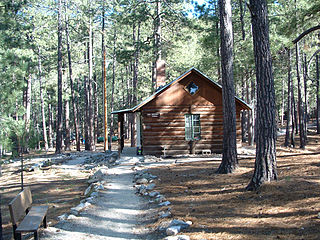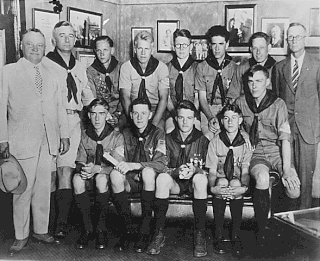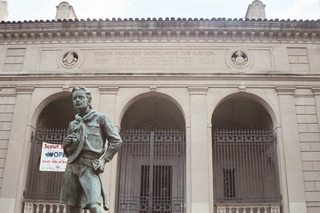
The Boy Scouts of America is one of the largest scouting organizations and one of the largest youth organizations in the United States, with over 1 million youth, including 176,000 female participants. The BSA was founded in 1910; about 130 million Americans have participated in its programs. Served by 477,000 adult volunteers. BSA became a founding member organization of the World Organization of the Scout Movement in 1922.

Scouting in Arizona has a long history, from the 1910s to the present day, serving thousands of youth in programs that suit the environment in which they live.

Scouting in Michigan has a long history, from the 1910s to the present day, serving thousands of youth in programs that suit the environment in which they live.

Scouting in Kentucky has a long history, from the 1910s to the present day, serving thousands of youth in programs that suit the environment in which they live. Kentucky has a very early Scouting heritage, as the home state of Daniel Carter Beard.

Scouting in North Carolina has a long history, from the 1910s to the present day, serving thousands of youth in programs that suit the environment in which they live.

Scouting in Vermont has a long history, from the 1907 to the present day, serving thousands of youth in programs that suit the environment in which they live.

Camp Fire, formerly Camp Fire USA and originally Camp Fire Girls of America, is a co-ed youth development organization. Camp Fire was the first nonsectarian, multicultural organization for girls in America. It is now gender-inclusive, and its programs emphasize camping and other outdoor activities.

Scouting in Rhode Island has a long history, from the 1910s to the present day, serving thousands of youth in programs that suit the environment in which they live.
Woodcraft League of America, originally called the Woodcraft Indians and League of Woodcraft Indians, is a youth program, established by Ernest Thompson Seton in 1901. Despite the name, the program was created for non-Indian children. At first the group was for boys only, but later it would also include girls. Seton instructed the children in his town in Connecticut in outdoor "Woodcraft" – knowledge and skills of life in the woods – and based much of the group's terminology and structure on the misconceptions about Native Americans that were common in that era. The program spread internationally to become the Woodcraft Movement and many of these programs still exist. Seton's Woodcraft scheme also had a strong influence on later youth programs and organizations, particularly, the Scout Movement.

Scouts BSA Handbook is the official handbook of Scouts BSA, published by the Boy Scouts of America. It is a descendant publication of Baden-Powell's original handbook, Scouting for Boys, which has been the basis for Scout handbooks in many countries, with some variations to the text of the book depending on each country's codes and customs.

James Edward West was a lawyer and an advocate of children's rights, who became the first professional Executive Secretary, soon renamed Chief Scout Executive, of the Boy Scouts of America (BSA), serving from 1911 to 1943. Upon his retirement from the BSA, West was given the title of Chief Scout.
Lone Scouts are members of the Scout movement who undertake scout activities on their own or by distance communication, usually because they live in isolated areas or otherwise do not participate in scout activities with other scouts. A Lone Scout may have an adult Scout leader or counselor who may instruct and supervise them. They can follow the same program as other Scouts and may advance in the same way as all other Scouts.

Scouting in the United States is dominated by the 1.2 million-member Boy Scouts of America and the Girl Scouts of the USA and other associations that are recognized by one of the international Scouting organizations. There are also a few smaller, independent groups that are considered to be "Scout-like" or otherwise Scouting related.

The Boy Scouts of America (BSA) was inspired by and modeled on The Boy Scouts Association, established by Robert Baden-Powell in Britain in 1908. In the early 1900s, several youth organizations were active, and many became part of the BSA.
The Scout and Guide movement in Australia consists of:
The Scout and Guide movement in New Zealand is served by

The Boy Rangers of America was a Scouting program in the United States for boys ages 8 through 12. It was organized on January 24, 1913 in Montclair, New Jersey by Emerson Brooks. Although independent of the Boy Scouts of America, it was the precursor of the BSA's Cubbing program now known as Cub Scouting.
Youth organizations in the United States are of many different types. The largest is the government run 4-H program, followed by the federally chartered but private Scouting movement groups: the Boy Scouts of America (BSA) and the Girl Scouts of the USA (GSUSA). Another somewhat smaller but co-ed Scouting derived group is Camp Fire. Other youth groups are religious youth ministries such as the evangelical Christian Awana, Seventh-day Adventist Pathfinders, and Assemblies of God Royal Rangers.

In the Boy Scouts of America, a Scout leader refers to the trained leaders of a Scout unit. Adult leaders are generally referred to as "Scouters," and the youth leaders are referred to by their position within a unit. In all Scouting units above the Cub Scout pack and units serving adolescent Scouts, leadership of the unit comprises both adult leaders (Scouters) and youth leaders (Scouts). This is a key part of the Aims and Methods of Scouting. In order to learn leadership, the youth must actually serve in leadership roles.












